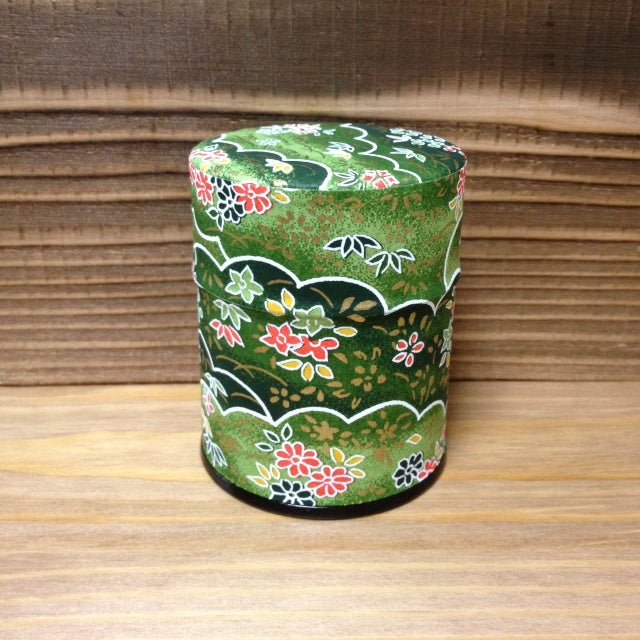Stripes, houndstooth, polka dots. These simple designs are common wardrobe staples, they adorn everything from furniture to electronics. They have a long history and are sure to stick around for a while. While also prominent in Japan, they also share the stage with traditional Japanese patterns.
A distinguished feature of Japanese art and design is the use of motifs. Japanese patterns are very recognizable and appear often on silverware, origami paper, and fabrics. Here’s a look at a few of the most popular patterns.
Sakura
桜 - Cherry blossoms are one of Japan’s greatest icons, and they appear in a variety of ways. They can appear as blossoms, petals, whole branches, or a mix of the three. Not only are they beautiful, the short life of sakura also symbolizes the transience of life, an important Buddhist concept. Life is beautiful and one should enjoy it fully, but there comes a time when the end is near and should be accepted gracefully. Sakura is also popularized in songs and stories.
Kiku - Chrysanthemums
菊 - Chrysanthemums symbolize longevity and rejuvenation, and they are very special flowers in Japan, given their close ties to the Imperial family. These golden blooms symbolize the emperor and the Chrysanthemum Throne, the Imperial Seal of Japan, and the Supreme Order of the Chrysanthemum. Other notable appearances are on Japanese passports and the 50 yen coin.
Ume - Plum
梅 - Keeping with the theme of flowers, next up is the plum blossom, which also has special meaning in Japan. Common associations are luck, nobility, purity, devotion, refinement, and protection against evil. Though overshadowed by cherry blossoms today, there was a time when plum blossoms were the flower of choice. Even now, it is still an important symbol of spring’s arrival, and plums are present in many delicious foods and drinks.
Seigaiha - Blue Sea Wave
青海波 - Another iconic pattern is the ancient seigaiha (sometimes seikaiha), or “blue sea wave”. A series of overlapping circles form arches that resemble waves. Appropriately, the shapes used to depict seas on old Chinese maps. They first appeared in Japan during the 6th century and are still popular designs today. The Japanese regard waves as lucky omens. They also represent resilience, power, and tactical strength.
Shippou - Seven Treasures

七宝 - Translated as “seven jewels”, this circular pattern extends into infinity. The name refers to the seven treasures of Buddhism: gold, silver, lapis lazuli, crystal, agate, red pearl, and carnelian. These correspond to faith, perseverance, humility, doing no wrong, mindfulness, concentration, and wisdom. There are often additional designs incorporated in the center of the circle, such as flowers or the actual treasures.
Asanoha - Hemp Leaves
麻の葉 - Literally “hemp leaf”, this pattern resembles the leaves of hemp plants, though that association came later. Originally created as a simple geometric shape, it took the name for the resemblance as well as importance of hemp in Japanese culture. Before the introduction of cotton, hemp was one of the primary fibers used for clothing. It has also been used in Shinto ceremonies for its perceived cleansing properties. Hemp is a fast-growing plant, and asanoha became associated with growth and good health. Many children’s clothing contain this pattern.
Karakusa - Arabesque
唐草 - Meaning “arabesque”, the twists and spirals of this pattern resemble plants or vines. Due to the healthy growth of vines, the pattern came to symbolize luck, prosperity, and eternity. It is also sometimes used to represent family lineages or legacies. Flowers frequently accompany the spiral-like design, such as lotuses or peonies, both popular flowers in Japan. These patterns are often chosen for house-warming or wedding presents. The "kara" or 唐 - comes from the term for the Tang dynasty and use often as a synonym for the country of China when items from that era were imported from China. In this case, researchers believe the pattern originates at the other end of the silk road in Egypt.
Kikko - Tortoise shell
亀甲 - Another geometric design, the tortoiseshell pattern originated in Western Asia and can be large or small. In Asian cultures, the tortoise represents longevity, and this pattern symbolizes luck and longevity. Additional designs can be found inside the hexagons, such as lucky motifs, flowers, or family crests. Kimono frequently feature tortoiseshell patterns.
Yagasuri - Arrows
矢絣 - This simple design is meant to resemble the fletching on Japanese arrows. Originally a popular men’s design due to its association with archery and strength, it became a common pattern for Meiji schoolgirls. Ever since, it has enjoyed great popularity on women’s clothing. Yagasuri also evokes the image of an arrow, shot straight and true. Thus, it came to symbolize steadfastness and determination. In Buddhism, bows and arrows also represent protection against evil. The pattern is particularly ideal for graduations and weddings.
Koi - Carp
鯉 - The beloved carp can often be found in Asian design, as well as swimming in ponds or parks. Japan regards them highly, and they symbolize luck, fortune, abundance, and perseverance. There is even a legend that tells of koi fish struggling to swim up the falls to the Dragon Gate on the Yellow River. If they succeed, they become a magnificent dragon. The Japanese greatly respect this ability to overcome, and many textiles feature these fish swimming bravely to success.
Same Komon - Shark Skin
鮫小紋 - When seen from far away, the textiles featuring this pattern seem to be a solid color. In truth, they are actually komon, or “fine patterns”, made up of very small details. They were the standard wear for samurai and courtiers of the day. It was also said that the finer the pattern, the more prestigious the wearer. Nowadays, the pattern decorates many kimono.









2 comments
I absolutely loved your post! Hope you could update the links since they are broken and I missed those pictures for better reference. Thank you!
Yunomi – Thank you very much for this great post! Can you please tell me the name of the pattern on this bowl? https://tabelog.com/imgview/original?id=r8572775196041